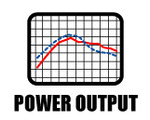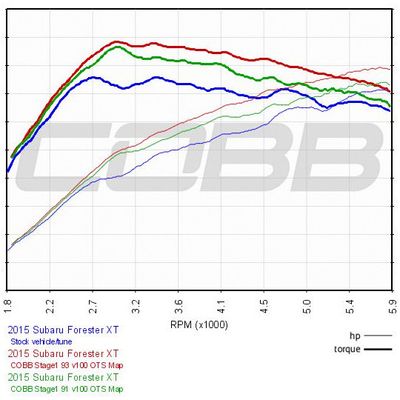Map Notes for SJ FXT
Supported Vehicles:
USDM 2014 - 2018 FXT
Map Revision:
| 2014-2016 | 2017-2018 |
|---|---|
|
|
Map Availability:
- Download from the COBB Tuning Subaru FXT OTS Map Database.
Required Accessport Firmware:
Map | Peak Gains* | Largest Gain* |
|---|---|---|
Stage1 93 | +11% HP / +17% TQ | +23% HP / +23% TQ at 3000 RPM |
*Peak gains are measured as the difference between the highest points of the two plots.
*Largest gains are measured as the largest gain at any single point between the two plots.
Results may vary. Power as tested on 2014 - 2015 FXT vehicles using these identical calibrations. Generally speaking, the 91 calibration has a richer fuel curve and a less aggressive ignition advance map to help compensate for 91 octane fuel and/or less than ideal atmospheric conditions. The map designed for 93 octane is the most aggressive.
Stage1 Map
- Intake Requirements: Stock airbox and stock air filter
- Exhaust Requirements: Stock
- Boost Targets:
- 91 Octane 95 RON Minimum: ~18.0psi peak boost pressure tapering down as you approach the 6100RPM redline, +/- 1.5psi.
- 93 Octane 98 RON Minimum: ~18.0psi peak boost pressure tapering down as you approach the 6100RPM redline, +/- 1.5psi.
Non-Performance Maps
Anti-Theft Mode
- Will not allow vehicle to start
Stage1 Economy
- Fuel Requirements:
- 91 octane or better
- Intake Requirements: Stock airbox and stock air filter
- Exhaust Requirements: Stock exhaust
- Boost Targets: Mechanical minimum
*Not intended for aggressive driving*
Stage1 Valet
- Fuel Requirements:
- 91 octane or better
- Intake Requirements: Stock airbox and stock air filter
- Exhaust Requirements: Stock exhaust
- Boost Targets: Mechanical minimum
- Rev Limiter: 4000 RPM
Monitoring Boost Levels:
The best way to determine if you are hitting target boost is to watch the TD Boost Error parameter. This parameter is your target boost (including altitude and temperature compensations) minus your actual boost (negative values mean you are over the target by the amount while positive values mean you are under). Ideally you want this value to be between 0 and 1.0 at wide open throttle (WOT), but -1.5 to 1.5 is acceptable assuming that you don’t have any significant knock corrections. Overboosting is more likely to occur in higher gears and with colder outside temperatures, so be sure to verify boost levels during these conditions.
High Altitude:
A quick note for those of you that live at higher altitudes. It is common for turbocharged cars at higher altitudes to run less boost pressure due to lower air pressure and air density. Your turbocharger has to work harder to compress a less dense air mass compared to the same turbocharger at sea level. This must be factored in when determining if your turbocharger is running the proper amount of boost pressure and not being pushed beyond its efficiency range.
Example: If you live in Denver at 5280 ft and are trying to run a peak boost pressure of 15 psi, your turbocharger has to work the equivalent of making ~17.5 psi at sea level.
There are barometric compensations within the factory ECU that lower boost targets as you climb in altitude in an effort to keep the turbocharger in its optimal range. The COBB performance maps utilize these compensations and therefore, it is perfectly normal for the final boost target to be lower than what is listed for your map.
Launch Mode:
Launch Mode is a custom feature added to Stage1 performance maps for the 2014-2016 FXT only. This feature will allow for a more aggressive brake-torque launch* and/or to minimize or eliminate performance reduction due to specific throttle closures in other situations. Launch Mode is currently not compatible with FXT CVT vehicles that are equipped with factory EyeSight option.
WARNING: Using the launch mode feature puts more stress on the transmission, drivetrain, engine and other
components and can result in increased wear of any of these components as well as the potential for catastrophic
failure. The more aggressive driving characteristics that are possible with the launch mode feature could also potentially result in an unexpected loss of vehicle control. This feature should only be used in controlled off-road racing conditions where all parties understand the risks involved.
To enable this feature you must hold down the cruise control CANCEL button on the steering wheel when cruise control is OFF (i.e. the cruise control icon on the dash is not illuminated). The CANCEL button must be held for as long as you want launch mode to be applied. Launch mode is only available during a brake-torque launch and a short period after the launch. The increase in torque after enabling launch mode while performing a brake-torque launch will not be instantaneous. Although still a relatively short period, it does take some time to build maximum boost/torque for the launch. That said, the time period the higher torque level is held should be minimized at all costs (see warning below).
WARNING: When staging for a brake-torque launch, the driver should hold the CANCEL button
the absolute minimum amount of time necessary in order to build enough boost for an aggressive launch. While
following this guideline is no guarantee against increased wear or catastrophic failure of any vehicle components,
longer periods of high engine torque when staging can be very detrimental to the vehicle.
* A brake-torque launch is a practice used with an automatic transmission where the driver uses the brake pedal with their left foot to hold the car stationary while they preload the drivetrain with their right foot on the gas pedal.
Revision Notes:
| Version # | Notes: |
|---|---|
| v401 | This map was updated to eliminate unnecessary DTC Supression or updated versions for parity with other maps/vehicles within the platform |
| v400 | This map was updated to eliminate unnecessary DTC Supression or updated versions for parity with other maps/vehicles within the platform |
| v350 | Maps have been updated to eliminate unnecessary DTC suppression. |
| v301 | Fixed bugs associated with v300 maps preventing real-time and launch control feature changes from working. |
| v300 | Supports new Subaru ECU revision which includes Subaru's recall-related pre-ignition changes and other updates. |
| v102 | Minor changes to Open Loop Fuel Targets. |
| v101 | Fixed rev limiter issue with Anti-theft and Valet Mode maps. |
| v100 |
|
Copyright 2023 © COBB Tuning Products LLC. All Rights Reserved. | www.cobbtuning.com



